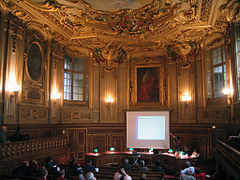Sorbonne
The Sorbonne (French: La Sorbonne) is the historic university in Paris, France. Heir to a secular humanist custom, it is an internationally renowned university of letters and humanities.
Along with the universities of Oxford, Bologna and Salamanca, it is one of the oldest and most prestigious universities in the world. It was founded in 1257 by Robert de Sorbón and completely reformed by Cardinal Richelieu. His famous teachers and students include Pierre and Marie Curie, Jean-Paul Sartre, Simone de Beauvoir, René Descartes, Louis Pasteur, Lavoisier, Pedro Paulet, Victor Hugo, Saint Ignatius of Loyola and Saint John Baptist de La Salle and Armando Uribe among much others.
The historic building is located in the center of Paris, in the 5th arrondissement, opposite the Samuel Paty park and the National Museum of the Middle Ages of Paris (to the south) and the Lycée Louis-le-Grand and the Collège de France (to the west), near the Pantheon in Paris and the Luxembourg Garden (which belongs to the Luxembourg Palace, seat of the French Senate), in the so-called Latin Quarter, where many higher schools are concentrated.
In its classrooms and amphitheatres, completely rebuilt between 1885 and 1901, today they mainly teach social sciences, economics, history, geography, law and philosophy.
Sorbonne College
The name derives from the Collège de Sorbonne (Sorbonne College), founded in 1257 by Robert de Sorbon, chaplain and confessor to King Louis IX (Saint Louis) of France, being one of the first significant colleges of medieval Paris, and created with the aim of facilitating the teaching of theology to poor students. The library was one of the first to organize items alphabetically by title. The University itself was however about a century older than the college, and other lesser schools had already been founded by the end of the century XII.
Three centuries later it became a privileged center for debates in the theology faculty and played an important role in the country's religious quarrels against the Jesuits in the 17th century XVI and against the Jansenists in the XVII century. The Collège de Sorbone was suppressed during the French Revolution, reopened by Napoleon in 1808, and finally closed in 1882. This was just one of many colleges of the University of Paris that existed before the Revolution. Hastings Rashdall, in his work The Universities of Europe in the Middle Ages (The Universities of Europe in the Middle Ages) of 1895 lists some 70 colleges of the university in only the Middle Ages; some of these were short-lived and disappeared before the end of the medieval period, while others were founded in the early modern age, such as the Collège des Quatre-Nations (College of the Four Nations).
Paris Faculty of Theology
Over time the college, though only one of many in the university, became the center of theological studies and the term "Sorbonne" was frequently used as synonymous with the Faculty of Theology of Paris.
University of Paris
During the second half of the XIX century, the buildings of the Collège de Sorbonne were used by the Faculties of Science and Literature of what was then known as the Academy of Paris, a name used to refer to the faculties of the former University of Paris within the centralized structure known as the University of France, created in 1808 but divided back into its original constituent universities in 1896. As a result of this, the "Sorbonne" it became a colloquial term to refer to the entire University of Paris.
The use of the name Sorbonne for the Faculty of Theology was still noted in the eleventh edition of the Encyclopedia Britannica (1910-1911) and in the Encyclopedia Católica of 1913, neither of which indicated that the word could refer to the university as a whole. Although probably none of these early XX century English encyclopedias were up-to-date with French usages of that time, yet it shows that this was an innovation and not yet very widespread.
- Sorbonne Units
Successor Institutions of n#34;La Sorbonne de Paris#34;
In 1970, the historic University of Paris was divided into thirteen different universities, considered true descendants of the historic college of "La Sorbonne" transformed into University:
- University of Paris I Panthéon-Sorbonne
- Panthéon-Assas University
- Sorbonne University New - Paris 3
- University of Paris IV Paris-Sorbonne
- University of Paris V Descartes
- Pierre University and Marie Curie
- University of Paris VII Denis Diderot
- University of Paris VIII
- Paris-Dauphine University
- University of Paris X Nanterre
- University of Paris-South
- University of Paris XII Val de Marne
- University of Paris XIII Sorbonne Paris-Nord
The thirteen universities are still run by the same Rectorate and have their offices in the same original headquarters of the Sorbonne. They are considered as successor universities for being a detachment of the original University of Paris.
Three of these institutions continued to include the original term Sorbonne in their names: the University of Paris I - "Panthéon-Sorbonne", the Sorbonne New University - Paris 3" and the University of Paris IV Paris-Sorbonne.
These three universities can be considered as privileged successors, because they are located in the same building and because they settled in the same Latin Quarter, seat of the original "Sorbonne de Paris" and because they also share the same teachers, the same administration and a continuous quality of teaching.
Occupations
The Sorbonne was occupied by about a thousand people during the events of May 1968. More recently it was occupied on March 10, 2006 by students protesting against the introduction of France's First Job Contract Law. Shortly after 5 p.m. that day, some two hundred people occupied the campus, and hundreds more joined the protests outside. At three in the morning, the police proceeded, in the midst of several clashes, to evict the occupants of the premises.
- =http://www.sorbonne-assas-ils.org/%7Ctitle=Sorbonne Assas – International Law School – High-level LL.M. in International Business Law/25070/website=www.sorbonne-assas-ils.org
Contenido relacionado
Soviet Union flag
History of Christianity during the Middle Ages
Act of Independence of the Mexican Empire




